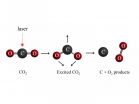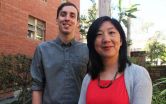Stochastic variations of migration speed between cells in clonal populations
2014-10-03
(Press-News.org) Microfluidic tools for precision measurements of cell migration speed reveal that migratory speed of individual cells changes stochastically from parent cells to their descendants, while the average speed of the cell population remains constant through successive generations.
A team of researchers at the Massachusetts General Hospital and Harvard Medical School in Boston has developed technologies for precision measurement of cell migration speed before and applied the new tool to study the variations of migration speed in population of cancer cells. This tool enabled comparisons between successive generations of cells with single cell resolution. One interesting finding from this study was that the speed of migration, maintained relatively constant throughout the life of a cell, is not inherited from the mother down to the daughter cells. Instead, the characteristic migration speed of each cell changes randomly through successive generations. This finding comes as a surprise, considering that the average migration speed of the larger cell population does not change through multiple cycles. This finding is important in the context of cancer treatment, where treatments are sought to slow down the invasion of cancer cells.
"Our finding suggests that a factor may exist which determines the characteristic speed of a cell and that factor is set at random levels in the new cells after cell division." says Daniel Irimia, M.D., Ph.D., of the Massachusetts General Hospital in Boston and senior author on this paper. "These measurements could not be performed today with any of the traditional tools for cell migration. Transwell assays could only compare population averages and lack single cell resolution. Wound healing assays have single cell resolution, however the results are confounded by frequent interactions between moving cells. Other more recent microfluidic devices are also hampered by the noise of measuring cell migration on flat surfaces, when the direction of migration changes frequently interfering with the velocity measurements."
Inside the microfluidic device, each cell is assigned one channel-track along which the cell will migrate for several hours. An automated microscope takes images every 20 minutes at multiple locations in the microfluidic device, and multiple devices at once, allowing for the tracking of dozens of cells in one experiment. Interestingly, each cell that migrates through the channels maintains its migration speed throughout its lifetime. Only some of the cells divide while in the channels, and those are scrutinized closely. To better visualize the cells through the division cycle, the researchers took advantage not only of fluorescent dyes, but also of a recently developed Fucci fluorescent marker. Using this marker, the green fluorescence of the nucleus increases progressively in cells in the growth phase and turns off after the division. "We optimized the design of the device such that most of the channels have only one cell traveling through at a time, and calculated the length of the channels such that we could observe each cell for an average of 12 hours" says Jun Yan, Ph.D., the lead author on this paper.
The team from the Massachusetts General Hospital plans to use the microfluidic devices in synergy with some more sophisticated molecular biology tools and identify the control factors of cell migration speed. "Identifying this factor could provide an interesting target for drugs to modulate how fast or slow cells move" says Dr. Irimia. In cancer, this could help slow down the migration of cancer cells, to delay their invasion and metastasis. After injuries of healthy tissues, we would like to accelerate the migration of healthy cells that move to close the wound.
INFORMATION:
This work was supported in part by funds from the National Institutes of Health (CA135601 and GM092804).
Corresponding author for this study in Technology is Daniel Irimia, dirimia@hms.harvard.edu.
[Attachments] See images for this press release:

ELSE PRESS RELEASES FROM THIS DATE:
2014-10-03
Scientists at the University of Granada, in collaboration with La Paz University Hospital in Madrid and the University of Texas, San Antonio in the US have demonstrated through several experiments conducted on Zucker obese rats that chronic consumption of melatonine helps combat obesity and diabetes mellitus type two.
Their research has confirmed that chronic administration of melatonine in young obese rats with diabetes mellitus type two, similar to its human equivalent, improves mitochondrial dysfunction (i.e. mitochondrial homeostatic functions) in a very efficient ...
2014-10-03
Social network analysis could improve knowledge sharing in the healthcare sector, according to research results published in the International Journal of Collaborative Enterprise.
Elizabeth Cudney, Steven Corns and Suzanna Long in the department of Engineering Management and Systems Engineering at Missouri University of Science and Technology, in Rolla, Missouri, USA, explain how knowledge management systems (KMS) can be critical in capturing, retaining and communicating project results and staff knowledge. They can prevent knowledge drain and provide training as "lessons ...
2014-10-03
Researchers at the University of Granada have designed a new imaging system capable of obtaining up to twelve times more colour information than the human eye and conventional cameras, which implies a total of 36 colour channels. This important scientific development will facilitate the easy capture of multispectral images in real time, and in the not too distant future it could also be used to develop new asisted vehicle driving systems, identify counterfeit bills and documents or obtain medical images much more accurate than current ones, among many other applications.
The ...
2014-10-03
Many of those who are genetically predisposed to develop atrial fibrillation, which dramatically raises the risk of stroke, can be identified with a blood test. This is shown by new research from Lund University in Sweden.
The number of people affected by atrial fibrillation is rising rapidly, partly as a result of the ageing population.
Over recent years, a research group at Lund University in Sweden, working with other universities and hospitals in Europe and the USA, has identified twelve genetic variants in the human genome that increase the risk of atrial fibrillation. ...
2014-10-03
Johnny Depp has an unforgettable face. Tony Angelotti, his stunt double in "Pirates of the Caribbean," does not. So why is it that when they're swashbuckling on screen, audiences worldwide see them both as the same person? Scientists from the University of California, Berkeley, have cracked that mystery.
Researchers have pinpointed the brain mechanism by which we latch on to a particular face even when it changes. While it may seem as though our brain is tricking us into morphing, say, an actor with his stunt double, this "perceptual pull" is actually a survival mechanism, ...
2014-10-03
yphoon Phanfone's eye appeared the size of a pinhole on visible imagery from NASA's Aqua satellite on Oct.3.
The MODIS instrument or Moderate Resolution Imaging Spectroradiometer that flies aboard NASA's Aqua satellite captured a visible image of Phanfone moving through the Northwestern Pacific Ocean on Oct. 3 at 4:20 UTC (12:20 a.m. EDT). The tiny open eye of the storm was surrounded by a thick band of thunderstorms. The MODIS image also showed a very thick and large band of thunderstorms south of the center and spiraling into the eye.
On Thursday, Oct. 2, Typhoon ...
2014-10-03
VIDEO:
Mexico's western coast is again dealing with rain, wind and rough surf from another tropical storm. NOAA's GOES-West satellite saw the formation of Tropical Storm Simon on Oct. 2. A...
Click here for more information.
Mexico's western coast is again dealing with rain, wind and rough surf from another tropical storm. NOAA's GOES-West satellite saw the formation of Tropical Storm Simon on Oct. 2. A NASA animation of NOAA's GOES-West satellite imagery shows the development ...
2014-10-03
About one-fifth of the Earth's atmosphere is oxygen, pumped out by green plants as a result of photosynthesis and used by most living things on the planet to keep our metabolisms running. But before the first photosynthesizing organisms appeared about 2.4 billion years ago, the atmosphere likely contained mostly carbon dioxide, as is the case today on Mars and Venus.
Over the past 40 years, researchers have thought that there must have been a small amount of oxygen in the early atmosphere. Where did this abiotic ("non-life") oxygen come from? Oxygen reacts quite aggressively ...
2014-10-03
Curiosity helps us learn about a topic, and being in a curious state also helps the brain memorize unrelated information, according to researchers at the UC Davis Center for Neuroscience. Work published Oct. 2 in the journal Neuron provides insight into how piquing our curiosity changes our brains, and could help scientists find ways to enhance overall learning and memory in both healthy individuals and those with neurological conditions.
"Our findings potentially have far-reaching implications for the public because they reveal insights into how a form of intrinsic motivation ...
2014-10-03
White Americans may view diversity and multiculturalism more negatively as the U.S. moves toward becoming a minority-majority nation, UCLA psychologists report.
As part of their study, the researchers divided 98 white Americans from all regions of the country — half male, half female, with an average age of 37 — randomly into two groups. One group was told that whites will no longer be the majority in the U.S. by 2050; in fact, this is likely to be true as soon as 2043, according to some projections. The second group was told that whites would retain their majority status ...
LAST 30 PRESS RELEASES:
[Press-News.org] Stochastic variations of migration speed between cells in clonal populations






